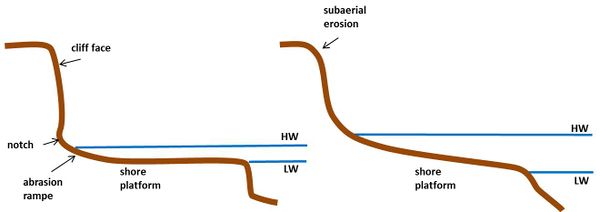Difference between revisions of "Rocky shore morphology"
Dronkers J (talk | contribs) (Created page with "==Formation <ref> Trenhaile, A.S. 2011. Cliffs and Rock Coasts. In: Treatise on Estuarine and Coastal Science Vol. 3, eds. Flemming, B.W. and Hansom, J.D., Elsevier, p. 171-19...") |
Dronkers J (talk | contribs) |
||
| Line 3: | Line 3: | ||
Rocky shores constitute about ¾ of the world coastline. Rocky shores can be very different from each other. This diversity depends, among other things, on cliff lithology, tectonic history, climate, waves and tides. Some rocky coasts are formed by steep plunging cliffs; this is observed in cases of very resistant rock, frequent extreme waves, volcanic activity or tectonic subsidence. More generally, shore platforms, which can be tens to hundreds of meters wide, exist in front of the cliffs. These shore platforms result from cliff retreat during the past millennia. Wave attenuation on the shore platform strongly reduces cliff recession rates<ref> Sunamura, T. 1992. Geomorphology of Rocky Coasts. Wiley, Chichester</ref>. Cliff retreat is often episodic, through toppling, slumping or sliding events, after notching of the cliff base by wave quarrying, abrasion and weathering. Marine dissolution processes are an important cause of notching of limestone cliffs. Debris fans at the cliff base after a slumping event are subsequently reworked into a shore platform. | Rocky shores constitute about ¾ of the world coastline. Rocky shores can be very different from each other. This diversity depends, among other things, on cliff lithology, tectonic history, climate, waves and tides. Some rocky coasts are formed by steep plunging cliffs; this is observed in cases of very resistant rock, frequent extreme waves, volcanic activity or tectonic subsidence. More generally, shore platforms, which can be tens to hundreds of meters wide, exist in front of the cliffs. These shore platforms result from cliff retreat during the past millennia. Wave attenuation on the shore platform strongly reduces cliff recession rates<ref> Sunamura, T. 1992. Geomorphology of Rocky Coasts. Wiley, Chichester</ref>. Cliff retreat is often episodic, through toppling, slumping or sliding events, after notching of the cliff base by wave quarrying, abrasion and weathering. Marine dissolution processes are an important cause of notching of limestone cliffs. Debris fans at the cliff base after a slumping event are subsequently reworked into a shore platform. | ||
| − | [[Image:ShorePlatform. | + | |
| + | [[Image:ShorePlatform.jpg|thumb|600px|centre|Figure: Typical rocky shore profiles. Left: Limestone cliff with low-tide terrace. Right: Hard rock cliff with sloping shore platform.]] | ||
Revision as of 12:43, 26 November 2015
Formation [1]
Rocky shores constitute about ¾ of the world coastline. Rocky shores can be very different from each other. This diversity depends, among other things, on cliff lithology, tectonic history, climate, waves and tides. Some rocky coasts are formed by steep plunging cliffs; this is observed in cases of very resistant rock, frequent extreme waves, volcanic activity or tectonic subsidence. More generally, shore platforms, which can be tens to hundreds of meters wide, exist in front of the cliffs. These shore platforms result from cliff retreat during the past millennia. Wave attenuation on the shore platform strongly reduces cliff recession rates[2]. Cliff retreat is often episodic, through toppling, slumping or sliding events, after notching of the cliff base by wave quarrying, abrasion and weathering. Marine dissolution processes are an important cause of notching of limestone cliffs. Debris fans at the cliff base after a slumping event are subsequently reworked into a shore platform.
Shore platforms [3]
Shore platforms can be either approximately horizontal, with a steep seaward edge, or gently seaward sloping. Sloping platforms prevail under tidal conditions and strong wave attack, whereas horizontal platforms are more common on micro-tidal coasts. High-tide terraces are typical for hard-rock coasts and low waves, low-tide terraces for limestone rocks. In the latter case erosion resistance of the platform surface can be enhanced by carbonate precipitation and other cementing agents (silica, iron). Soft cliffs often have a beach at the base, with an intertidal veneer of sand and gravel.
Shore platforms are also subject to erosion. The rate of platform down-wearing ranges from less than 1 mm/year to a few cm/year. Attack by waves armoured with rock fragments is an effective erosion mechanism, which polishes the platform surface. Fine abrasive material is washed away by waves and currents. However, platform surfaces usually present also many irregularities, with gullies, ponds and potholes scoured in faults, joints and in outcrops of less resistant rock around hard outcrops. Chemical and physical weathering plays an important role, through the effects of alternate wetting and drying, salt crystallization and frost. Marine organisms contribute to platform erosion by grazing activity (surface scraping) and by boring of holes (by bivalves). Algae (e.g. kelp) can provide protection against erosion, but plant roots can also widen crevices and dislodge rock fragments.
References
- ↑ Trenhaile, A.S. 2011. Cliffs and Rock Coasts. In: Treatise on Estuarine and Coastal Science Vol. 3, eds. Flemming, B.W. and Hansom, J.D., Elsevier, p. 171-192
- ↑ Sunamura, T. 1992. Geomorphology of Rocky Coasts. Wiley, Chichester
- ↑ Bird, E.C.F. 2008. Coastal Geomorphology: An Introduction, Second Edition. JohnWiley and Sons, Ltd, pp. 411
Please note that others may also have edited the contents of this article.
|
